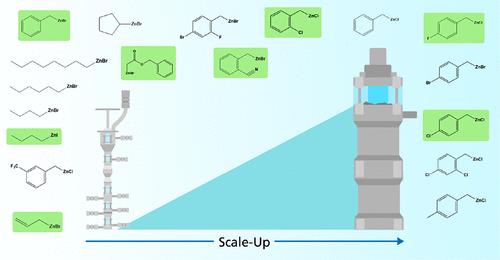当前位置:
X-MOL 学术
›
Org. Process Res. Dev.
›
论文详情
Our official English website, www.x-mol.net, welcomes your feedback! (Note: you will need to create a separate account there.)
Continuous Scalable Synthesis and Concentration Variation of Organozinc Compounds
Organic Process Research & Development ( IF 3.4 ) Pub Date : 2024-05-02 , DOI: 10.1021/acs.oprd.4c00078 Lars Gössl 1 , Kai Dahms 1 , Gabriele Menges-Flanagan 1 , Michael Maskos 1
Organic Process Research & Development ( IF 3.4 ) Pub Date : 2024-05-02 , DOI: 10.1021/acs.oprd.4c00078 Lars Gössl 1 , Kai Dahms 1 , Gabriele Menges-Flanagan 1 , Michael Maskos 1
Affiliation

|
In the production of pharmaceutically active ingredients, the formation of new carbon–carbon bonds is essential. A widespread and frequently employed method is the use of organometallic reagents (e.g., RLi, RMgX, RZnX), which differ greatly in their reactivity and are selected according to the specific reaction pathway desired. Organozinc compounds (RZnX) represent a class of compounds whose reactivity is lower than that of the widely used Grignard reagents and far below that of organolithium compounds, allowing them to tolerate the presence of functional groups incompatible with organomagnesium and organolithium compounds. Organozinc compounds are highly sensitive to oxygen and moisture, which results in difficult handling and problematic storage and limits the use of organozinc compounds in synthetic chemistry. In order to overcome this limitation and make organozinc reagents widely accessible for process chemists of varying industries, a continuous synthetic route to a large number of organozinc reagents was established on a laboratory and pilot scale. Flow rates, solvents, the metal activation mechanism, and the initial concentration of the starting materials were varied. For this purpose, a bed of Zn granules was used, which provides an approximately 250-fold excess of Zn throughout the reaction. The formed zinc organyls were analyzed by manual titration and GC analysis after quenching to determine conversion and yield as well as possible side product formation. For the formation of monozinc organyls, a lab-scale reactor originally designed for the formation of Grignard reagents was used, including a Zn replenishing unit. The main objective of this work was to establish the scalable continuous formation of organozinc reagents, which enables fast and safe process optimization. It was found that complete conversion of the organic halides used could be achieved in a single passage through the reactor with zinc organyl yields of 78–100%. Furthermore, the continuous conversion of highly concentrated 2.0 M starting materials was successfully carried out for the first time. Sufficient process reliability was ensured, and good to very good yields of 84–100% were demonstrated. The synthesis of some selected zinc organyls was then also transferred to a pilot scale, where a maximum liquid throughput of 18 L/h was achieved. With residence times of 1.5–14.0 min, complete conversion of the organic halide was achieved in all syntheses with high zinc organyl yields of up to 98%.
中文翻译:

有机锌化合物的连续规模化合成和浓度变化
在药物活性成分的生产中,新碳-碳键的形成至关重要。一种广泛且经常使用的方法是使用有机金属试剂(例如,RLi、RMgX、RZnX),它们的反应性差异很大,并且根据所需的特定反应途径进行选择。有机锌化合物(RZnX)代表一类反应活性低于广泛使用的格氏试剂且远低于有机锂化合物的化合物,使其能够耐受与有机镁和有机锂化合物不相容的官能团的存在。有机锌化合物对氧气和水分高度敏感,这导致处理困难和储存问题,并限制了有机锌化合物在合成化学中的使用。为了克服这一限制并使有机锌试剂可供不同行业的过程化学家广泛使用,在实验室和中试规模上建立了大量有机锌试剂的连续合成路线。流速、溶剂、金属活化机制和起始材料的初始浓度各不相同。为此,使用了 Zn 颗粒床,在整个反应过程中提供了约 250 倍过量的 Zn。淬火后通过手动滴定和GC分析来分析形成的有机锌,以确定转化率和产率以及可能的副产物形成。为了形成有机基单锌,使用了最初设计用于形成格氏试剂的实验室规模反应器,包括锌补充装置。这项工作的主要目标是建立有机锌试剂的可扩展连续形成,从而实现快速、安全的工艺优化。结果发现,所用有机卤化物的完全转化可以在一次通过反应器的过程中实现,有机基锌的产率为 78-100%。此外,首次成功进行了高浓度2.0M起始原料的连续转化。确保了足够的工艺可靠性,并证明了 84-100% 的良好到非常好的收率。然后,一些选定的有机锌的合成也转移到中试规模,其中实现了 18 L/h 的最大液体吞吐量。停留时间为 1.5–14.0 分钟,所有合成中都实现了有机卤化物的完全转化,有机锌收率高达 98%。
更新日期:2024-05-02
中文翻译:

有机锌化合物的连续规模化合成和浓度变化
在药物活性成分的生产中,新碳-碳键的形成至关重要。一种广泛且经常使用的方法是使用有机金属试剂(例如,RLi、RMgX、RZnX),它们的反应性差异很大,并且根据所需的特定反应途径进行选择。有机锌化合物(RZnX)代表一类反应活性低于广泛使用的格氏试剂且远低于有机锂化合物的化合物,使其能够耐受与有机镁和有机锂化合物不相容的官能团的存在。有机锌化合物对氧气和水分高度敏感,这导致处理困难和储存问题,并限制了有机锌化合物在合成化学中的使用。为了克服这一限制并使有机锌试剂可供不同行业的过程化学家广泛使用,在实验室和中试规模上建立了大量有机锌试剂的连续合成路线。流速、溶剂、金属活化机制和起始材料的初始浓度各不相同。为此,使用了 Zn 颗粒床,在整个反应过程中提供了约 250 倍过量的 Zn。淬火后通过手动滴定和GC分析来分析形成的有机锌,以确定转化率和产率以及可能的副产物形成。为了形成有机基单锌,使用了最初设计用于形成格氏试剂的实验室规模反应器,包括锌补充装置。这项工作的主要目标是建立有机锌试剂的可扩展连续形成,从而实现快速、安全的工艺优化。结果发现,所用有机卤化物的完全转化可以在一次通过反应器的过程中实现,有机基锌的产率为 78-100%。此外,首次成功进行了高浓度2.0M起始原料的连续转化。确保了足够的工艺可靠性,并证明了 84-100% 的良好到非常好的收率。然后,一些选定的有机锌的合成也转移到中试规模,其中实现了 18 L/h 的最大液体吞吐量。停留时间为 1.5–14.0 分钟,所有合成中都实现了有机卤化物的完全转化,有机锌收率高达 98%。































 京公网安备 11010802027423号
京公网安备 11010802027423号